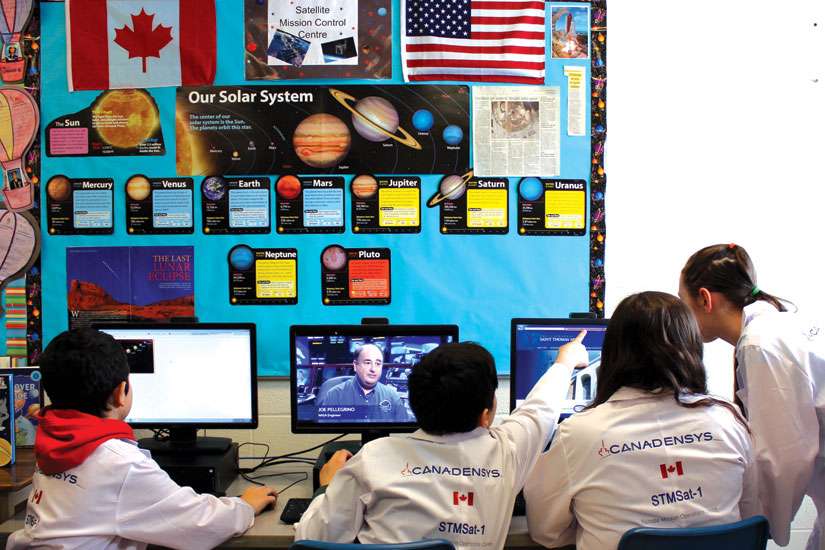St. John Paul II is the only Canadian school involved in a project directly linking students with a satellite that is photographing Earth from space. The school is serving as a Remote Missions Operations Centre (RMOC) for the STMSat-1 Mission.
The centre involves three work stations, one in each of the school’s Grade 6 classrooms, with the main station serving as a direct link between the students and the satellite.
Canadensys Aerospace Corporation, a space systems and services company based in Toronto, provided the school with an antenna and software to carry out the project.
“It is a great opportunity for them to learn about space, to become engaged in inquiry,” said Carmen Condotta, the teacher/librarian who established the partnership. “We want to spark them, we want to engage them and we want them to be asking questions. This project is all about that.”
Once the images are collected, the 26 Grade 4, 5 and 6 students from the ROMC Group, will exchange information for comparison with the central command post at St. Thomas More Cathedral School in Arlington, Virginia, where students designed and built the satellite with the support of advisors from NASA.
This takes place in the other two classrooms which serve as communication centres between the schools.
Launched from the Kennedy Space Centre in Florida on Dec. 6, 2015, the satellite, the first of its kind to be built entirely by elementary school students, is currently docked at the International Space Station. On May 11 STMSat-1 is expected to be off on its own orbiting about 300 km above the Earth where it will remain for the next eight to 12 months.
“It will circle around (the Earth) taking pictures and it will be our students’ job when the satellite is in range to get those pictures from the antenna that will speak to the satellite,” said Condotta. “Up until this point their job has been to ensure that the program, the software and hardware are all in working order. They’ve (also) been practising how to track satellites.”
Along with the students in the ROMC Group, all of the Grade 6 classes have been actively engaged in the project as part of the curriculum. Isabella Bracaglia has been engaged on both fronts.
“I love space,” said Bracaglia. “Space is never ending and therefore the experience of learning about space never ends.”
Dylan Kurnath, a Grade 5 student, says the whole project proves that age, education and experience are not the defining characteristics related to one’s ability to make a difference.
“Even though we are not NASA engineers or developers,” he said, “kids can still make a difference.”
As part of the project Canadian astronaut Jeremy Hansen visited the school on April 7 to inspect the ROMC and speak to students about his journey towards space, the importance of education and to always remember that obstacles should only detour, not deter, one from following their dreams.
A message written collaboratively by the Grade 6 students for Hansen said, “It is a privilege to be the only Canadian school to act as a Remote Operation Centre for this mission,” because “it will allow us to have a first-hand experience of a real-life space mission.”
St. John Paul II principal George Consitt agrees it is a privilege to have such a hands-on role in the project.
“We are privileged to have been invited to be the only Remote Mission Operation Centre outside the United States,” he said. “Our students will have a chance to participate in an actual space mission in various ways. This is a truly unique experience that has fired the imaginations of teachers and students alike.”
Inspiring students by providing experiences that expose them to possible career paths is exactly what education is all about at the elementary level, said Condotta.
“It is important to get them thinking and questioning not just about space but everything and about anything,” she said. “We would hope that we have future leaders in technology and space or medical fields within our walls (and) we would hope that we provide something to help them make the connection between their gifts and talents and where they want to go in life.
“This is what this particular project does... it makes that connection for them and it gives them little snippets of what skills they might need to get there in terms of a career."


